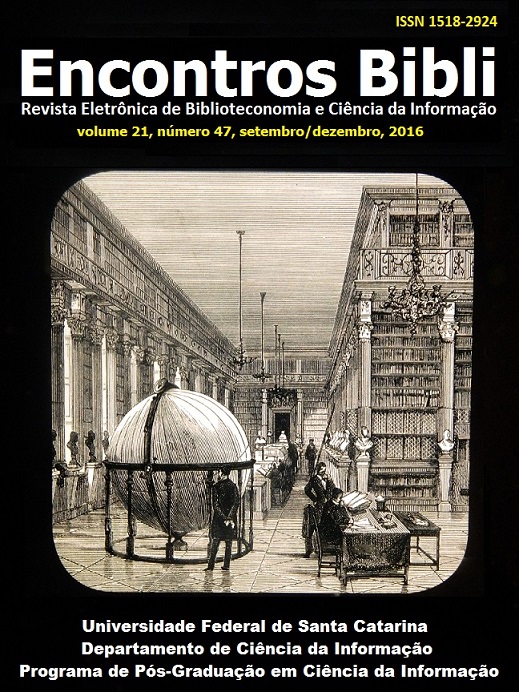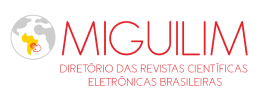Acoplamento bibliográfico e análise de cocitação: revisão teórico-conceitual
DOI:
https://doi.org/10.5007/1518-2924.2016v21n47p82Palabras clave:
Análise de cocitação, Acoplamento bibliográfico, Análise relacional de citação, Análise de domínioResumen
A análise relacional de citação, realizada sobretudo pelos métodos de cocitação e de acoplamento bibliográfico, permite conhecer as relações estruturais de conectividade teórico-metodológica de um domínio, a proximidade, a vizinhança, a associação e a interlocução estabelecida entre documentos e pesquisadores, entre outros, como reconhecidos pela comunidade científica. Esses dois métodos têm sido utilizados, individualmente, para a compreensão da comunicação científica, a frente de pesquisa e a estrutura intelectual de domínios científicos. Recentemente, tem se observado estudos comparativos entre eles a fim de verificar suas adequações e eficiência como indicadores de similaridade ou proximidade temática. Neste contexto, dada a importância desses métodos para as análises bibliométricas e de domínio, este estudo tem por objetivo discutir aspectos teóricos e conceituais inerentes aos dois métodos de análise das relações entre citações, Análise de Cocitação de Autores e Análise de Acoplamento Bibliográfico de Autor, visando contribuir para as reflexões e desenvolvimento dos estudos teórico-metodológico brasileiros na temática.
Descargas
Citas
AHLGREN, P.; JARNEVING, B.; ROUSSEAU, R. Requirements for a cocitation similarity measure, with special reference to Pearson’s correlation coefficient. Journal of the American Society for Information Science and Technology, v. 54, n.6, p.550-560, 2003.
BAYER, A. E.; SMART, J. C.; McCLAUGHLIN, G. W. Mapping intellectual structure of a scientific subfield through author cocitations. Journal of the American Society for Information Science, v. 41, n. 6, p.444 - 452, 1990.
BELLARDO, T. The use of co-citations to study science. Library Research, v.2, n.3, p. 231-237, 1980.
BÖRNER, K.; CHEN, C.; BOYACK, K. W. Visualizing knowledge domains. Annual Review of Information Science and Technology, v. 37, n. 1, p. 179-255, 2003.
BOYACK, K.; BÖRNER, K.; KLAVANS, R. Mapping the structure and evolution of chemistry research. Scientometrics, v. 79, n.1, p. 45–60, 2009.
BOYACK, K. W.; KLAVANS, R. Co-citation analysis, bibliographic coupling, and direct citation: Which citation approach represents the research front most accurately? Journal of the American Society for Information Science and Technology, v. 61, n. 12, p. 2389–2404, 2010.
CABANAC, G. Accuracy of inter-researcher similarity measures based on topical and social clues. Scientometrics, v. 87, n.3, p. 597–620, 2011.
CALLON, M.; COURTIAL, J-P.; PENAN, H. Cienciometría – La medición de la actividad científica: de la bibliometría a la vigilância tecnológica. Asturias: Ediciones Trea, S.L., 1995.
CARVALHO, M.M. Análise bibliométrica da literatura de Química no Brasil. Ciência da Informação, v. 4, n. 2, 119-141, 1975.
COUTO, T. et al. Classifying documents with link-based bibliometric measures. Information Retrieval, v. 13, p. 315-345, 2010.
ECK, N. J. V.; WALTMAN, L. Appropriate similarity measures for author co-citation analysis. Journal of the American Society for Information Science and Technology, v. 59, n. 10, p.1653-1661, 2008.
EGGHE, L.; ROUSSEAU, R. Co-citation, bibliographic coupling and a characterization of lattice citation networks. Scientometrics, v. 55, n. 3, p. 349-361, 2002.
GARFIELD, E. From Bibliographic Coupling to Co-Citation Analysis via Algorithmic Historio-Bibliography A Citationist’s Tribute to Belver C. Griffith. Conferência ministrada em Drexel University, Philadelphia. 2001 Disponível em: <http://garfield.library.upenn.edu/papers/drexelbelvergriffith92001.pdf >. Acesso em: 02 de julho de 2015.
GLÄNZEL, W. Bibliometrics as a research field: a course on theory and application of bibliometric indicators. Bélgica, 2003. Disponível em: <http://citeseerx.ist.psu.edu/viewdoc/download?doi=10.1.1.97.5311&rep=rep1&type=pdf Acesso em: 9 de janeiro de 2011.
GMÜR, M. Co-citation analysis and the search for invisible colleges: A methodological evaluation. Scientometrics, v. 57, n. 1, p. 27-57, 2003.
GRÁCIO, M. C. C.; OLIVEIRA, E. F. T. Análise de cocitação de autores: um estudo teórico-metodológico dos indicadores de proximidade, aplicados ao GT7 da ANCIB. Liinc em Revista, v. 9, p. 196-213, 2013.
GRÁCIO, M. C. C.; OLIVEIRA, E. F. T. Estudos de Análise de Cocitação de Autores: uma abordagem teórico-metodológica para a compreensão de um domínio. Tendências da Pesquisa Brasileira em Ciência da Informação, v. 7, p. 1-22, 2014.
GRÁCIO, M. C. C.; OLIVEIRA, E. F. T. Indicadores de proximidades em Análise de Cocitação de Autores: um estudo comparativo entre Coeficiente de Correlação de Pearson e Cosseno de Salton. Informação & Sociedade, v. 25, n.2, 2015.
HJØRLAND, B.; ALBRECHTSEN, H. Toward a new horizon in Information Science: Domain-Analysis. Journal of the American Society for Information Science, v.6, n. 6: 400-425, 1995.
HJØRLAND, B. Domain analysis in information science: eleven approaches-traditional as well as innovative. Journal of Documentation, v.58, n.4, p. 422-462, 2002.
HJØRLAND, B. Citation analysis: A social and dynamic approach to knowledge organization. Information Processing and Management, v. 49, p. 1313–1325, 2013.
HUANG, M.-H.; CHANG, C.-P. A comparative study on detecting research fronts in the organic light-emitting diode (OLED) field using bibliographic coupling and co-citation. Scientometrics, v. 102, p. 2014-2057, 2015.
JARVENING, B. A comparison of two bibliometric methods for mapping of the research front. Scientometrics, v. 65, n. 2, p. 245-263, 2005.
JARVENING, B. Bibliographic coupling and its application to research-front and other core documents. Journal of Informetrics, v. 1, p. 287–307, 2007.
KESSLER, M. M. Bibliographic coupling between scientific papers. American Documentation, v. 14, p. 10–25, 1963.
KESSLER, M. M. Comparison of the results of bibliographic coupling and analytic subject indexing. American Documentation, v. 16, n.3, p. 223–233, 1965.
LEYDESDORFF, L. On the normalization and visualization of author co-citation data: Salton’s cosine versus the Jaccard index. Journal of the American Society for Information Science and Technology, v. 59, n. 1, p.77-85, 2008.
LEYDESDORFF, L.; VAUGHAN, L. Co-occurrence Matrices and their applications in Information Science: Extending ACA to the Web environment. Journal of the American Society for Information Science and Technology, v. 57, n. 12, p.1616-1628, 2006.
LU, K.; WOLFRAM, D. Measuring author research relatedness: A comparison of word‐based, topic‐based, and author cocitation approaches. Journal of the American Society for Information Science and Technology, v. 63, n.10, p. 1973-1986, 2012.
LUCAS, E. O.; GARCIA-ZORITA, J. C.; SANZ-CASADO, E. Evolução histórica de investigação em informetria: ponto de vista espanhol. Liinc em Revista, v. 9, n. 1, p. 255-270, maio, 2013.
LUCAS, E. O.; GARCIA-ZORITA, C. Produção Científica sobre Capital Social:estudo por acoplamento bibliográfico. Em Questão, v. 20, n. 3, ed. esp., p. 27-42, 2014.
LUUKKONEN, T. et al. The measurement of international scientific collaboration. Scientometrics, Amsterdam, v. 28, n. 1, p. 15-36, 1993.
MA, R. Author bibliographic coupling analysis: a test based on a Chinese academic database. Journal of Informetrics, v. 6, n.4, p. 532–542, 2012.
MACIAS-CHAPULA, C. A. O papel da informetria e da cienciometria e sua perspectiva nacional e internacional. Ciência da Informação, Brasília, v.27, n.2, p.134-40, maio/ago. 1998.
McCAIN, K. Mapping author intellectual space: a technical overview. Journal o the American Society for Information Science. v.41, n.66, p.433-443, 1990.
MARSHAKOVA, I.V. Citation networks in Information Science. Scientometrics, v. 3, n. 1, p. 13-26, 1981.
MATTOS, A.M.; DIAS, E.W. Análise de Cocitação de Autores: questões metodológicas. IN: XI Encontro Nacional de Pesquisa em Ciência da Informação: Inovação e inclusão social: questões contemporâneas da informação, Rio de Janeiro, 2010. Anais..., 2010.
MIGUEL, S.; MOYA-ANEGON, F.; HERRERO-SOLANA, V. A new approach to institutional domain analysis: Multilevel research fronts structure. Scientometrics, v. 74, n.3. p. 331-344, 2008.
OLIVEIRA, E.F.T; GRÁCIO, M.C.C. Studies of Author Cocitation Analysis: A Bibliometric Approach for Domain Analysis. Iris, v.2, n.1, p.12-23, 2013.
QIU, J. P.; DONG, K.; YU, H-Q. Comparative study on structure and correlation among author co-occurrence networks in bibliometrics. Scientometrics, v. 101, p. 1345-1360, 2014.
ROUSSEAU, R. Bibliographic coupling and co-citation as dual notions. A Festschrift in Honour of Peter Ingwersen, e-Zine of the ISSI , vol.esp., p. 173–183, 2010.
ROSTAING, H. La bibliométrie e ses techniques. Tolouse: Sciences de la Société, 1996.
SMALL, H. Cocitation in the scientific literature: A new measure of the relationship between two documents. Journal of the American Society for Information Science, v. 24, p. 265–269, 1973.
SMALL, H. On the shoulders of Robert Merton: towards a normative theory of citation. Scientometrics, v. 60, n.1, p. 71-79, 2004.
SMALL, H.; SWEENEY, E. Clustering the Science Citation Index using co-citations: 1. A comparison of methods. Scientometrics, v.7, n. 3-6, p.391-409, 1985.
SMIRAGLIA, R.P. A glimpse at Knowledge Organization in North America: an editorial. Knowledge Organization, v. 34, n.2, p.69-71, 2007.
SMIRAGLIA, R.P. Modulation and Specialization in North American Knowledge Organization: visualizing pioneers. In Proceedings form North American Symposium on Knowledge Organization, v. 2, p. 35-46, 2009.
SMIRAGLIA, R.P. ISKO 11’s Diverse Bookshelf: an editorial. Knowledge Organization, v. 38, n.3, p. 179-186, 2011.
WHITE, H. D. Cocited author retrieval online: an experiment with the social indicators literature. Journal of the American Society for Information Science and Technology, v. 32, p.16-21, 1981.
WHITE, H. D.; GRIFFITH, B. C. Author co-citation: a literature measure of intellectual structure. Journal of the American Society for Information Science and Technology, v. 32, n.3, p.163-171, 1981.
WHITE, H.D.; MCCAIN, K.W. Visualizing a discipline: an author co-citation analysis of Information Science, 1972-1995. Journal of the American Society for Information Science, v. 49, n. 4, p. 327-355, 1998.
ZHAO, D.; STROTMANN, A. Evolution of Research Activities and Intellectual Influences in Information Science 1996–2005: Introducing Author Bibliographic-Coupling Analysis. Journal of the American Society for Information Science and Tecnhology, v. 59, n. 13, p. 2070-2086, 2008.
ZHAO, D.; STROTMANN, A. The Knowledge Base and Research Front of Information Science 2006–2010: An Author Cocitation and Bibliographic Coupling Analysis. Journal of the American Society for Information Science and Tecnhology, v. 65, n. 5, p. 995-1006, 2014.
Publicado
Cómo citar
Número
Sección
Licencia
Derechos de autor 2016 Maria Cláudia Cabrini Grácio

Esta obra está bajo una licencia internacional Creative Commons Atribución 4.0.
El autor debe garantizar:
que existe un consenso total de todos los coautores para aprobar la versión final del documento y su presentación para su publicación.
que su trabajo es original, y si se han utilizado el trabajo y / o las palabras de otras personas, estos se han reconocido correctamente.
El plagio en todas sus formas constituye un comportamiento editorial poco ético y es inaceptable. Encontros Bibli se reserva el derecho de utilizar software o cualquier otro método para detectar plagio.
Todas las presentaciones recibidas para su evaluación en la revista Encontros Bibli: revista electrónica de biblioteconomía y ciencias de la información pasan por la identificación del plagio y el auto-plagio. El plagio identificado en los manuscritos durante el proceso de evaluación dará como resultado la presentación de la presentación. En el caso de identificación de plagio en un manuscrito publicado en la revista, el Editor en Jefe llevará a cabo una investigación preliminar y, si es necesario, la retractará.
Esta revista, siguiendo las recomendaciones del movimiento de Acceso Abierto, proporciona su contenido en Acceso Abierto Completo. Por lo tanto, los autores conservan todos sus derechos, permitiendo a Encontros Bibli publicar sus artículos y ponerlos a disposición de toda la comunidad.
Los contenidos de Encontros Bibli están licenciados bajo Licencia Creative Commons 4.0.

Cualquier usuario tiene derecho a:
- Compartir: copiar, descargar, imprimir o redistribuir material en cualquier medio o formato
- Adaptar: mezclar, transformar y crear a partir del material para cualquier propósito, incluso comercial.
De acuerdo con los siguientes términos:
- Atribución: debe otorgar el crédito apropiado, proporcionar un enlace a la licencia e indicar si se han realizado cambios. Debe hacerlo bajo cualquier circunstancia razonable, pero de ninguna manera sugeriría que el licenciante lo respalde a usted o su uso.
- Sin restricciones adicionales: no puede aplicar términos legales o medidas tecnológicas que restrinjan legalmente a otros de hacer cualquier cosa que permita la licencia.


























